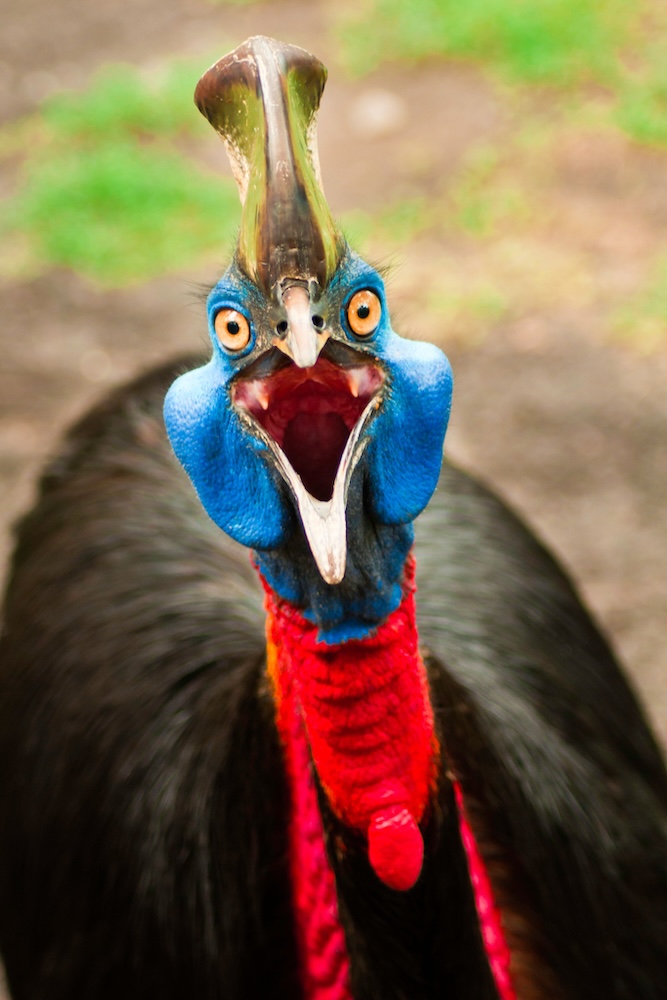Deep in the rainforests of Papua New Guinea, Indonesia, and northern Australia, a creature roams the undergrowth with all the stealth and danger of a dinosaur. Standing up to two metres tall and weighing as much as 60 kilograms, the cassowary is a striking bird and the most dangerous one in the world. This bird has earned its fearsome reputation with its sharp claws and aggressive temperament.
While cassowaries primarily feed on fruit and seeds, their behaviour around humans and animals can be frighteningly hostile. The bird’s muscular legs, ending in three sharp claws, serve as powerful weapons, with one talon capable of growing up to 12 centimetres long. This dagger-like claw has proven deadly on more than one occasion. When threatened, the cassowary will launch itself at lightning speed, using its legs to kick and claw at perceived threats.
A Deadly History
The cassowary’s reputation for violence isn’t without merit. One of the first fatal encounters occurred in 1926 when a teenage boy named Phillip McClean and his brother came face to face with a cassowary on their farm in Australia. The bird attacked them, and when Phillip stumbled and fell, the cassowary struck with a fatal blow to his neck, severing his jugular vein. This event marked the first known death caused by a cassowary, and its deadly potential has not diminished since then.
Over the years, there have been more reports of cassowary attacks. A particularly tragic incident took place in Florida in 2019, when a 75-year-old man, Marvin Hajos, was killed by his own cassowary after falling near the bird’s enclosure. The massive bird, likely feeling threatened, delivered a lethal kick. Despite immediate efforts by first responders, Marvin did not survive.
Though these attacks are rare, they underscore the power and unpredictability of this bird. Between 1990 and 2012, over 200 attacks were recorded, with many resulting in serious injuries to humans and dogs. Dogs, in particular, seem to be frequent victims of cassowary aggression, and several fatal attacks on dogs have been reported.

Ancient Allies?
Despite their terrifying reputation, humans have a long history with cassowaries. Evidence suggests that as early as 18,000 years ago, ancient people in New Guinea may have domesticated these birds. Researchers studying fragments of cassowary eggs found burn marks on some, indicating they were cooked and eaten. However, other eggs were nearly fully developed, suggesting that the people may have been hatching and raising cassowary chicks.
Interestingly, cassowary chicks imprint on the first creature they see after hatching, making them relatively easy to manage in their early years. However, their natural aggression emerges once they reach adulthood, making them dangerous to their human caretakers. Collecting cassowary eggs would not have been easy either. The birds’ nests, well hidden in the dense forest, are fiercely guarded by the males, meaning ancient New Guineans had to be skilled and brave to steal the eggs.
A Modern-Day Threat
The cassowary’s natural habitat is shrinking. As rainforests are cut down to make way for farms and developments, encounters between humans and these birds have increased. In some areas, like Queensland’s Mission Beach, cassowaries have started wandering into gardens and tourist spots, putting both themselves and people at risk.
While cassowaries prefer to avoid humans, habitat loss pushes them into more frequent contact with people. Cars, dogs, and fences pose a significant threat to the birds, with many dying yearly due to accidents or attacks. Conservationists urge people to give these birds space, especially during breeding season when they are more likely to feel threatened and act aggressively.
In the wild, the cassowary is an elusive bird, preferring to move quietly through the dense undergrowth of the rainforest. Yet, despite their preference for solitude, these birds will not hesitate to defend themselves when they feel cornered. Environmental organisations work hard to educate people living in cassowary habitats, offering advice such as not feeding the birds, keeping dogs on a leash, and backing away slowly if confronted by one of these feathered giants.



























































